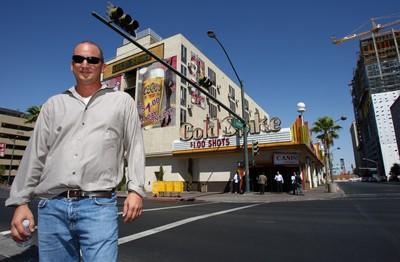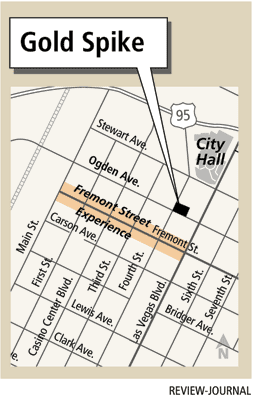Downtown dream


Gregg Covin has visited the Gold Spike.
Yes, he still plans to buy it.
The Miami developer of high-rise condos and historic boutique hotels visited downtown Las Vegas last week for a closer look at the Gold Spike, a small hotel-casino that’s known for its smoky atmosphere and dirt-cheap prices.
Covin, 38, has a purchase agreement to buy the Spike for $15.6 million from Tamares Las Vegas Properties. His plan is to revive the property, seedy even by downtown Las Vegas standards, as a boutique-style hotel with room rates in the neighborhood of $125 to $150 per night.
It would be Covin’s first project in Las Vegas, and although downtown and casino enthusiasts wish him well, there’s also plenty of skepticism among Sin City bloggers who aren’t convinced the Gold Spike can become the area’s first real boutique property.
One Las Vegas blogger, making note of Covin’s plans to upgrade the Spike, calls the developer “some idiot,” one of the tamer critiques of his plans.
During a visit to Las Vegas last week to look at the hotel, Covin was undaunted by the skepticism. He said the Gold Spike is far from the roughest property he’s converted since taking over his family’s real estate business about 20 years ago after his father’s death.
“To me it seems good,” Covin said shortly after an inspection tour. “I’m used to working on buildings built in 1920.”
Covin’s plans for the property aren’t complete, although he does have a general vision. In the short-term he said he’ll retain the current management company to run the property.
“It will stay as is for a little while,” Covin said.
He envisions a tidy hotel with the same number of rooms and a large lobby with a casino and bar. The layout, Covin said, will be typical of what boutique hotel customers look for: a throwback hotel with friendly service and a lobby where customers spend time with drinks and conversation.
He’ll look for partners with experience in Las Vegas to help incorporate the casino aspect.
“I’ll probably announce when I close (the sale) that I’ll have some local partners with expertise,” he said.
The Gold Spike, which Covin said was built in 1983, although Clark County property records indicate the building dates to 1976, is structurally sound and has adequate fire and safety systems.
Covin said the decision to buy it was the product of years of scouting Las Vegas for real estate opportunities. Covin had planned to build a version of his 50-story residential building in downtown Miami called Ten Museum Park. But the market for condominiums declined in Las Vegas, so he scrapped that plan.
But he kept an eye on Las Vegas real estate, and when the Gold Spike went on sale in May he jumped in.
“The condo market slowed so I stopped looking for a time, but I got to know a lot of the Realtors,” Covin said. “(The Gold Spike) looked like an ideal project for me.”
The five-story building has slightly fewer than 110 hotel rooms and the casino is about 5,800 square feet — in comparison, Binion’s has about 87,000 square feet of casino space and the Golden Nugget about 38,000.
Longtime Las Vegas casino owner Jackie Gaughan owned and operated the Gold Spike from 1983 to 2004 when he sold it to a partnership that included Tamares and Barrick Gaming. The new ownership group removed the table games and pared the menu at the Gold Spike cafeteria. The changes sapped the downmarket charm from the property, according to former fans.
“I would be sad about the loss of the Gold Spike if it hadn’t already been turned into a ghost of itself,” said Matt Weatherford, a frequent downtown Las Vegas visitor who reviews casinos on the Web site Cheapovegas.com.
Whether Covin can succeed is another question. There are signs the downtown market, which has posted declining gaming revenue every year for more than a decade, is poised for a turnaround.
Terry Caudill, owner of the Four Queens, recently agreed to buy Binion’s for $32 million and intends to turn around the historic casino’s losing ways. Gaughan’s company recently spent about $20 million refurbishing the casino, hotel rooms and exterior facade of the El Cortez. CIM Group, a Hollywood company that invests in urban real estate, recently purchased the Lady Luck and announced plans to reopen it and attract more business to Third Street between the Fremont Street Experience and Stewart Avenue.
But there are also signs the market remains stagnant.
Tamares, which still owns the Plaza, Las Vegas Club and Western properties, still appears to be cost-cutting. The company closed the Western’s 837 hotel rooms, the Upper Deck restaurant at the Las Vegas Club and the Diner in the Plaza.
In April, the Fremont Street area hosted the Las Vegas Grand Prix auto race with much fanfare, but the event didn’t do much to boost gambling revenue, and casino owners complained that barricades hindered foot traffic.
Weatherford says it’s hard to tell whether hopes for a revived downtown are rooted in the economics of a low barrier to entry for new investors and a consumer push for authenticity or simply nostalgia for a version of Las Vegas that isn’t coming back.
“I love downtown, but I’m not naive enough to think it can just keep going on like it has,” Weatherford said. “The El Cortez is the model for improving while keeping the old spirit. I don’t know if other places should try the same thing, though, because I don’t know what the market is for that old-school experience. It is more something people talk about missing than actually want.”












